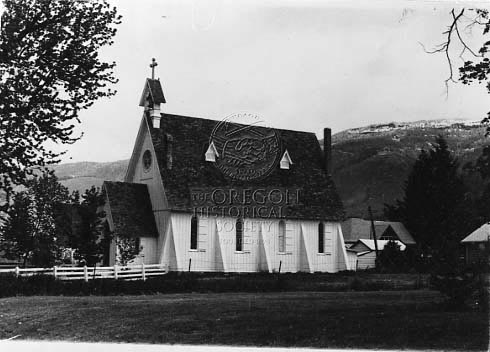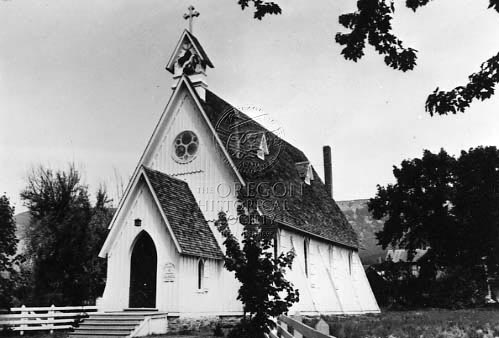Reuben Denton Nevius—clergyman, missionary, educator, and botanist—founded thirty Episcopalian congregations in eastern Oregon and Washington in the second half of his long and active life. He directed the building of at least fifteen churches and is credited with the conceptual design of many more.
Nevius was born on a farm near Ovid in the Finger Lakes region of New York, living briefly in New England after the early death of his father. After graduating from Union College in Schenectady, New York, he was a teacher in Michigan, where he began a serious scientific interest in botany. Although raised as a strict Calvinist Presbyterian, Nevius became an Episcopalian.
In 1850, Nevius joined his brother John in Columbus, Georgia. He boarded in the home of the Rev. Thomas Fielding Scott, who would later be elected first Missionary Bishop of the Oregon and Washington Territories. Following religious study, Nevius was ordained and soon moved to the diocese of Alabama, where he served the church in Wetumpka and taught in an Episcopalian high school.
Nevius moved to Christ Church in Tuscaloosa in 1855. His interest in botanical science intensified, and he began four decades of correspondence with Asa Gray at Harvard University, sending him samples of plants and searching out examples at Gray’s request. Gray named five new plant species after Nevius, including two native to Oregon—Chaenactis Nevii (Nevius's sunflower, John Day Valley) and Allium Nevii (Nevius's wild onion, Hood River area).
Although a Northerner, Nevius remained in Tuscaloosa during the Civil War. Following the war, in 1866 he accepted an invitation to become Rector of All Saints’ Church in Oil City, Pennsylvania. While there, he married Margaret Tuomey. In 1869, the couple relocated to Mobile, Alabama, where Nevius had been appointed Rector of St. John’s Episcopal Church, but Margaret died from yellow fever the following year.
In 1872, Nevius was invited to become Rector of Trinity Church in Portland, but because of difficulties with governing members of the congregation he was assigned to a wide circuit in eastern Oregon. In 1873, he laid the cornerstone for St. Peter’s church in La Grande, using a design that had been previously obtained, perhaps from a Portland architect.
Tirelessly crisscrossing northeastern Oregon, Nevius established seven new congregations. Six small churches were designed and built under his care, beginning with St. John’s in Union in 1873-1875. There is a consistency in style across many of these churches, which have a pronounced bold and heavy externalized cross-braced timber frame, stiffened by external side buttresses, usually with a small framed belfry to the side. Essentials of this scheme are mirrored by Nevius-founded churches: Ascension Church in Cove, St. Paul's Church in The Dalles (later enlarged), and All Saints Church in Weston, but especially in St. Thomas’s Church in Canyon City, built in 1876-1877, which was carefully restored in the year of its centennial.
Nevius’s circuit later expanded to eastern Washington and Idaho, where he served nine churches (building three). Between 1883 and 1912, he served twenty-three more churches in western Washington and Alaska and supervised the building of five new buildings.
Many of Nevius's churches survive and are still in service. Of the total twenty-eight Pacific Northwest Episcopal churches which he established and built, twenty are still standing, a remarkable statistic since all but one were built of wood.
Nevius retired to Tacoma, Washington, but still served as officiating priest of St. Peter's Church there; he also remained an active naturalist. He died on December 14, 1913, in Tacoma, Washington, at age eighty-six.
-
![Note enclosed wooden buttresses. Constructed in 1876.]()
Ascension Episcopal Church, Cove, OR with gothic architecture..
Note enclosed wooden buttresses. Constructed in 1876. Oregon Historical Society Research Library, 021571
-
![]()
Ascension Episcopal Church, Cove, OR, built by Rev. R.D. Nevius.
Oregon Historical Society Research Library, 021570
Map This on the Oregon History WayFinder
The Oregon History Wayfinder is an interactive map that identifies significant places, people, and events in Oregon history.
Further Reading
Allen, Albert E. Mission Accomplished: The Life of Reuben Denton Nevius, D.D. New York: Vantage Press, 1998.
Powers, David W. and Gregory L. Nelson. A Gentlemen of the Old School: Reuben Denton Nevius, 1827-1913, Botanist, Builder, Teacher, Churchman. Keiser, Ore.: Gregory L. Nelson, 2001.





